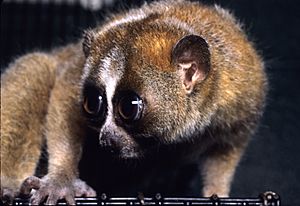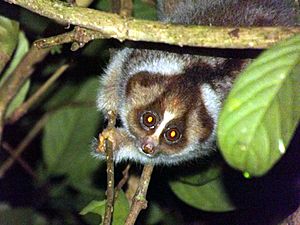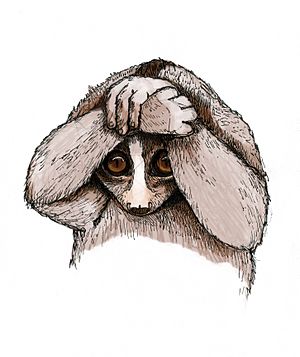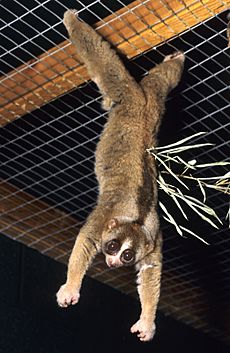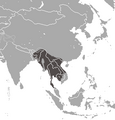Slow loris facts for kids
Quick facts for kids Slow lorises |
|
|---|---|
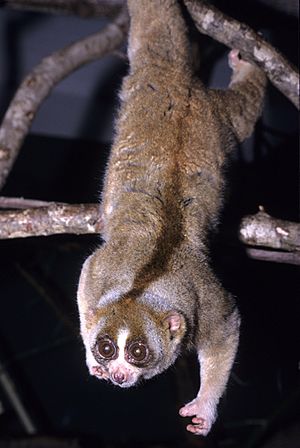 |
|
| Sunda slow loris | |
| Conservation status | |
| Scientific classification |
|
| Kingdom: | Animalia |
| Phylum: | Chordata |
| Class: | Mammalia |
| Order: | Primates |
| Suborder: | Strepsirrhini |
| Family: | Lorisidae |
| Subfamily: | Lorinae |
| Genus: | Nycticebus É. Geoffroy, 1812 |
| Type species | |
| Tardigradus coucang Boddaert, 1785
|
|
| Species | |
|
|
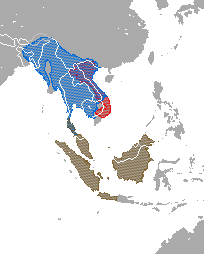 |
|
| Where slow lorises live
red = X. pygmaeus; blue = N. bengalensis; brown = N. bancanus, N. borneanus, N. coucang, N. javanicus, N. kayan & N. menagensis |
|
Slow lorises are a group of small, furry animals that live in trees. They are a type of primate, like monkeys and apes. These animals are nocturnal, which means they are most active at night. They belong to a group called the genus Nycticebus.
Contents
Where Slow Lorises Live
Slow lorises live in parts of Southeast Asia and nearby areas. You can find them from Bangladesh and Northeast India in the west, all the way to the Sulu Archipelago in the Philippines in the east. In the north, they live in the Yunnan province of China, and in the south, they are found on the island of Java.
These animals live in warm, wet places like rainforests. They also live in areas with bamboo and mangrove trees. Slow lorises prefer forests where the tree branches are high and thick. Some have even been seen in places changed by humans, like cacao farms.
Types of Slow Lorises
For a long time, people thought there were only a few types of slow lorises. But now, scientists have identified at least eight different species:
- the Sunda slow loris (N. coucang)
- the Bengal slow loris (N. bengalensis)
- the Javan slow loris (N. javanicus)
- the Philippine slow loris (N. menagensis)
- the Bangka slow loris (N. bancanus)
- the Bornean slow loris (N. borneanus)
- the Kayan River slow loris (N. kayan)
- the Sumatran slow loris (N. hilleri)
There is also a ninth species, the pygmy slow loris (X. pygmaeus). It was recently placed in its own new group called Xanthonycticebus.
Sadly, many slow loris species are in danger. Groups like the IUCN Red List have listed them as "Vulnerable" or "Endangered". This means their populations are shrinking and they need protection.
Slow Lorises' Relatives
The pygmy slow loris is a close relative. After that, the closest relatives of slow lorises are the slender lorises, which live in southern India and Sri Lanka.
Their next closest relatives are other lorisids from Africa. These include the pottos, false pottos, and angwantibos. Slow lorises are not as closely related to the different types of galagos. They are even more distantly related to the lemurs that live in Madagascar.
Discovery of Slow Lorises
The first time a slow loris was written about in science was in 1770. A Dutch scientist named Arnout Vosmaer described a Bengal slow loris he had seen two years earlier.
The word "loris" was first used in 1765 by a French scientist named Georges-Louis Leclerc, Comte de Buffon. He used it because it sounded like a Dutch word, loeris. This word means "a clown" in Dutch.
What Slow Lorises Look Like
Slow lorises have a round head and a small nose. They have very large eyes and unique patterns of fur color. Their arms and legs are almost the same length. Their body is long and can bend easily. This helps them reach out to branches that are far away.
Their hands and feet can grip branches very strongly, like a pair of pincers. This allows them to hold on for a long time. Slow lorises have a special and rare ability: a toxic bite! This is very unusual for mammals and unique among primates. They get the toxin by licking a special gland on their arm. The toxin becomes active when it mixes with their saliva. Scientists first thought this toxic bite was mainly to scare off predators. But now they know it's mostly used when slow lorises fight with each other.
Slow lorises have eyes that face forward. This gives them stereo vision, which means they can see depth. They can see well in low light, but they have monochromatic vision. This means they see in shades of only one color, not like humans who see many colors. They cannot see the colors blue and green.
Slow lorises can weigh from about 265 grams (less than a pound) for the Bornean slow loris, up to 2100 grams (about 4.6 pounds) for the Bengal slow loris. They have strong bodies, and their tails are very short, hidden under their thick fur.
Slow Loris Behavior
Slow lorises move slowly and carefully. They make very little noise. If they feel threatened, they stop moving and stay completely still. Since they are nocturnal, they are most active when it's dark outside.
We don't know much about how they live together in groups. But we do know they communicate by leaving their scent on things, which is called scent marking. Adult male slow lorises are very protective of their areas and can be aggressive towards other males.
They don't make many loud calls or alarm sounds. In Indonesia, people call slow lorises malu malu, which means "shy one." This is because they freeze and cover their face when someone spots them.
Who Hunts Slow Lorises?
Besides humans, the only animals known to hunt slow lorises are snakes, changeable hawk-eagles, and orangutans. It's also thought that cats, viverrids (like civets), and sun bears might hunt them. To protect themselves, slow lorises sometimes rub their venom on their fur. This helps to defend them from predators.
Reproduction and Life Cycle
Slow lorises have babies slowly. When they are born, the baby lorises are either left on branches or carried by one of their parents.
They can have babies throughout the year. In slow lorises kept in zoos, mating mostly happens between June and mid-September. Pregnancy lasts about 185 to 197 days. Baby lorises weigh between 30 and 60 grams (about 1 to 2 ounces) when they are born. Female slow lorises can start having babies when they are 18 to 24 months old. Males can start reproducing at 17 months. However, male fathers often become unfriendly towards their male babies after 12 to 14 months and will chase them away.
In zoos, slow lorises can live for 20 years or even longer.
What Slow Lorises Eat
Slow lorises are omnivores, meaning they eat both plants and animals. They eat insects, spiders, small birds, and reptiles. They also eat eggs, fruits, tree gums, nectar, and other plant parts.
Slow lorises have a very slow metabolism. This means their bodies use energy much slower than most other mammals of their size. This might be because they need to get rid of toxic chemicals from some of the food they eat. For example, slow lorises can eat the bark of the Gluta tree, which can be deadly to humans.
Slow Lorises and Humans
People have many old beliefs about slow lorises. Some believe these animals have special powers, like being able to stop evil spirits or heal wounds. Because of these beliefs, slow lorises are often used in traditional medicine.
In one part of North Sumatra, people believe that burying a slow loris under a house or road brings good luck. In the same area, parts of slow loris bodies were used to put curses on enemies. In Java, some thought that putting a piece of a slow loris skull in a water jug would make a husband more gentle and obedient, just like a slow loris during the day. In Cambodia, the gall bladder of the Bengal slow loris was used to make ink for tattoos. There's also a traditional Cambodian medicine called "loris wine," made from loris bodies mixed with rice wine, which is supposed to help with childbirth pain.
Laws exist to stop the trade of slow lorises and their products. They are also protected by international rules under Appendix I. But even with these laws, slow lorises are still sold openly in animal markets in Southeast Asia. They are also smuggled to other countries, like Japan. Because of their large eyes, which help them see at night, they are sometimes seen as "cute" pets in viral videos on YouTube. Sadly, for the pet trade, slow lorises often have their teeth cut or pulled out.
Slow lorises are sold in local street markets and also online and in pet stores around the world. They are very popular in Japan, especially among women. The Japan Wildlife Conservation Society says they are popular because "they're easy to keep, they don't cry, they're small, and just very cute."
However, slow lorises actually make very poor pets. They are active at night, need special diets, and are hard to care for. Many pet slow lorises die from infections, blood loss, or not getting the right care and food.
Protecting Slow Lorises
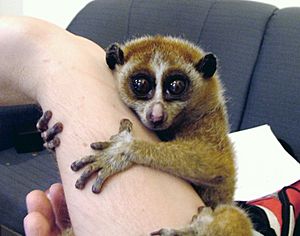
The two biggest dangers to slow lorises are deforestation (when forests are cut down) and the wildlife trade. Slow lorises have lost a lot of their natural homes. But even more than habitat loss, their numbers are dropping because of the illegal trade. People buy them as exotic pets or for traditional medicine.
Slow lorises in zoos are not doing very well either. In 2008, out of 29 slow lorises in North American zoos, many were mixed species that couldn't have babies. Most were also too old to reproduce. The last time these species had a baby in a North American zoo was in 2001. Pygmy slow lorises are doing better in zoos. Since they were first brought to North America in the late 1980s, their population grew to 74 animals by 2008. Most of these were born at the San Diego Zoo.
Images for kids
See also
 In Spanish: Loris perezosos para niños
In Spanish: Loris perezosos para niños


